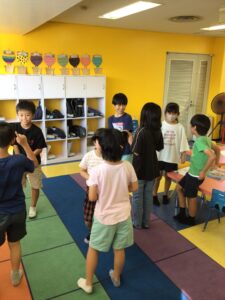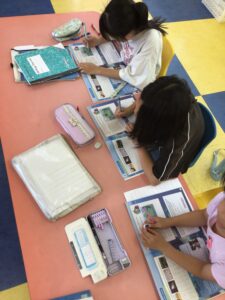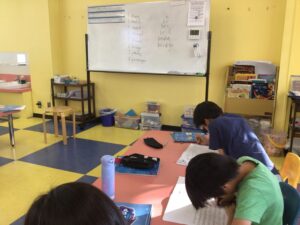It’s been a busy few months for Green class and we’ve already written letters to our favorite characters, given a concert of a song we wrote ourselves and joined a carnival march with our homemade maracas. Alongside this, we have been focusing on different skills each lesson, and here, we’re going to show you some of what we’ve been doing.
Greenクラスでは、好きなキャラクターに手紙を書いたり、自作曲のコンサートを開いたり、クラスで作ったマラカスでカーニバルをしたりと、忙しい数か月が過ぎました。それに加え、毎回のレッスンでは様々なことにフォーカスしています。

An important part of each lesson is our opening circle time, it lets us introduce today’s topic and gives the class the opportunity to discuss their ideas and opinions. Here, the class is finding out two new things about their partners before telling a different partner what they have learned. This develops both listening and speaking skills and gives them the chance to interact naturally in English. As one of the opening activities, it is important to jump into using our English from the beginning and in natural situations.
まず、レッスンはじめのサークルタイムは大切です。その日のトピックを紹介し、子ども達が意見やアイデアを話し合う機会でもあります。この日はパートナーについて、新しい2つのことを聞き出し、それを違うパートナーに説明しました。このアクティビティを通して、リスニングやスピーキングスキルが養われ、英語での自然な交流をすることができます。レッスンの開始とともに英語を自然に使えるようなアクテビティを大切にしています。

Of course, the textbook is another part of our lessons and we do a wide range of activities that build reading, writing, listening and speaking skills. In our class, we try to develop the textbook activities into other ideas too. For example, in one lesson we read a passage about Carnival in Brazil, and after that, we made our own maracas so we could have a samba party in class. In this picture, we had learned about different musical instruments and decided to pretend to play them in a music concert. These activities are a fun way to bring the textbook activities to life.
また、テキストの時間も大切なレッスンの一部です。リーディング、ライティング、リスニング、スピーキング力を養えるような幅広いアクティビティを行っています。Greenクラスでは、テキストのアクティビティを活用して、他のアクティビティを行うこともあります。例えば、ある日のレッスンでは、ブラジルのカーニバルについての記事を読んだので、マラカスを作り、サンバパーティーを行いました。上記の写真では、様々な楽器について学んでいるところで、この後もミュージックコンサートを演じてみることにしました。このように、テキストで学んだことを実践するようにしています。

Spelling is something we focus on each lesson, usually between 4 and 8 new words. Each time we use a range of techniques to help learn and visualize them. “Look, Cover, Write, Check” is something we do with all new vocabulary words. These four stages help us memorize the word and here, in this picture, the pyramid. In the pyramid, the children spell the word by building it up one letter at a time and the technique is great for more difficult words as it allows the children to focus on each individual letter.
毎回、スペリングにもフォーカスしており、4つ~8つの新しい単語を学習しています。様々なテクニックを使って学習をしていますが、「Look、Cover、Write、Check(見る、カバーする、書く、確認する)」という手順で新しいボキャブラリーを学んでいます。この4つのステップを守ることで単語を覚えることができます。写真に写っているホワイトボードには、アルファベットを1つずつ増やし、ピラミッドのように単語ができあがる順番を表示しています。こうすることで難しい単語のスペリングも学びやすくなります。
Martin